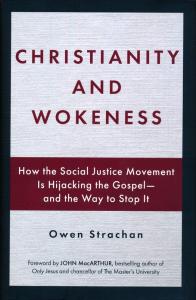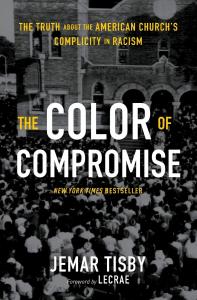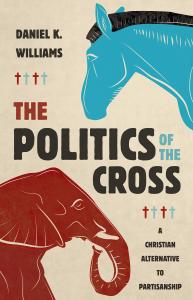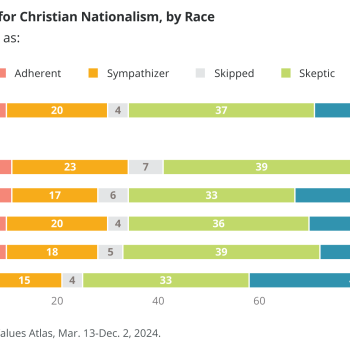It was the title that first caught my eye. Evangelical theologian Owen Strachan named his recent book, Christianity and Wokeness, after the classic 1923 fundamentalist critique of liberal Protestantism, Christianity and Liberalism by J. Gresham Machen.
As a fellow author, I know that writers don’t always get to choose their own book titles. But Strachan leans into this parallel within the book’s text. In his introduction, Strachan writes of Christianity and Liberalism that “Machen famously defined liberalism [liberal Protestantism] not as a different form of Christianity, but as a different thing altogether” (3). Strachan then proceeds to lay out the case that the same thing is true of “wokeness” in our time.
 He describes this contemporary system of thought as “a successor to the Protestant liberalism that so reshaped American Protestantism one hundred years ago” (128), and claims that it similarly constitutes a “once-in-a-lifetime crisis” and, quoting John MacArthur, “the greatest danger to the Church…in six decades.” (26)
He describes this contemporary system of thought as “a successor to the Protestant liberalism that so reshaped American Protestantism one hundred years ago” (128), and claims that it similarly constitutes a “once-in-a-lifetime crisis” and, quoting John MacArthur, “the greatest danger to the Church…in six decades.” (26)
For context, the reason that Machen, along with other fundamentalists, claimed that liberal Protestants actually taught a completely different religion was because, even though they used the same language as historic Christianity, they denied the “fundamentals” of the Christian faith. (Hence the name “fundamentalist.” It was not originally a slur as it often is today.)
Prominent among these essential doctrines were the deity of Jesus, his virgin birth, the efficacy of his death for atonement (his death actually accomplished the forgiveness of sins rather than merely demonstrating love), his physical resurrection, and his bodily return at the end of time. (For full disclosure, I agree that these convictions constitute a necessary part of the Christian faith.)
Strachan argues that, similarly, “wokeness” cannot be adopted by the church, even in part, because while it shares some similar language and concepts with historic Christianity (such as justice and restitution), at its core it stands opposed to orthodox Christian doctrine. This claim needs some unpacking:
Strachan notes that the term “woke” originally referred to being “awake” to and aware of the racial inequities still present in American society, especially as articulated by “Critical Race Theory” (CRT), the legal theory that analyzes society in terms of racial power dynamics. But he also states that what he calls the overall concept of “wokeness” does not admit of a single, precise definition, and should instead be considered “a mindset and a posture” (8).
As short-hand for all of this, Strachan labels as “woke” anyone who believes that “structural” or “systemic” racism in the United States exists. He uses structural and systemic racism interchangeably, but chooses the latter to define in the glossary: “the idea that race-based injustices are secretly embedded in the laws, policies, values, histories, institutions, language, and even thought categories created by the dominant white race” (212).
Strachan argues that this belief is problematic for several reasons. First, he claims it is derived from a Marxist analytical framework that divides society in terms of the oppressor and the oppressed, rather than seeing the unity of all people as created in the image of God. Hence it causes the very divisions it claims to heal. Additionally, if racism is defined as something other than conscious personal discrimination, then it is not something that can be solved by individual repentance, but rather requires political and economic intervention. Since utopia is not possible on earth, this obligation would be ongoing. The concept of structural racism therefore leads to unjust guilt placed on white people, who could never be free of their unwitting contribution to and benefit from a racist system simply through repentance and forgiveness. They would rather have to constantly work off this ultimately unpayable debt through continuous anti-racist activism. Thus, in Strachan’s analysis, wokeness is antithetical to the gospel.
What’s odd is that in multiple places throughout the book, Strachan simultaneously allows that it is technically possible that structural racism exists. He criticizes “woke” voices for arguing that empirical inequalities (of income, education level, etc.) between the races constitute automatic evidence that the nation’s social structures unfairly advantage white people over Black people. But, in fairness, he does acknowledge it is possible. He goes on to claim, though, that if this is true, there will be clear evidence connecting the cause and the outcome. And then he asserts that he hasn’t seen any.
Readers simply have to take his word for this because nowhere in this 200-page book does Strachan lay out his opponents’ arguments for the reality of structural racism, despite the fact that this is the chief claim he intends the book to counter.
As even a superficial survey of writings on the subject would demonstrate, the argument for structural racism is not simply “inequality exists so continuing discrimination must exist.” Instead, it is based in history. The argument is actually, “Past sin created a world where the average white American and the average Black American are born into very different circumstances, which has resulted in continuing inequality.” Here is the argument in brief:
250 years of race-based slavery meant that even after the emancipation of enslaved people, the vast majority of white Americans considered African Americans less capable in all respects and not worthy of the same privileges and opportunities, while the vast majority of African Americans had almost no wealth at all. The subsequent years of legalized segregation that followed close on the heels of the Civil War then resulted in far fewer opportunities for Black Americans to acquire education and employment and accumulate financial assets, all the way up through the civil rights reforms of the mid-1960s.
At this point it would be tempting to say that because it has been nearly 60 years since the end of legalized segregation (and the disfranchisement of Black voters), there is no longer any “structural” or “systemic” barrier to African Americans achieving full economic and social equality with white Americans. So any remaining gaps must be explainable some other way. And this is what Strachan argues.
Strachan mentions only two present statistical inequalities Black Americans experience: “African Americans between the ages of ten and thirty-four die from homicide at thirteen times the rate of white Americans” and “Black people account for about 23 percent of those shot and killed by police; they are about 13 percent of the U.S. population” (118). He pairs this with a counter-statistic: in 2018, “‘white’ people committed suicide at the rate of about 17 people per 100,000….This rate was about 10 people per 100,000 higher than ‘black,’ ‘Hispanic,’ and ‘Asian/Pacific Highlander’ [sic]” (115).
Strachan does not attempt to offer explanations for any of these three disparities. He uses the latter to question the existence of pervasive “white privilege,” says we should be wary of “monocausality” in explaining the homicide statistic, and in response to police shootings points out that in 2019 police shot 25 unarmed white men and only 14 unarmed Black men—without mentioning that there are roughly 4 times more white men than Black men in the United States, so a proportionate number would be only 6 unarmed Black men shot. (In fairness, his point seems to have been that these numbers are relatively low overall, but failing to be specific is misleading.)
 Here are some additional statistics Strachan does not mention, courtesy of Christian historian Jemar Tisby’s The Color of Compromise:
Here are some additional statistics Strachan does not mention, courtesy of Christian historian Jemar Tisby’s The Color of Compromise:
“A 2011 study revealed that a typical white household had sixteen times the wealth of a black one. According to a 2014 report, for every dollar in a white household, a black household has less than seven cents. Black people comprise about 13 percent of the population but hold less than 3 percent of the nation’s total wealth.” (198)
These are enormous disparities. By failing to mention them, Strachan gives the impression that Christians concerned about structural racism are making much ado about nothing. Thinking through a bit more of the history helps explain why these extreme differences have persisted beyond the end of legal segregation. Consider only one aspect of this history, the long-term effects of “redlining,” the practice of refusing to sell real estate in nicer areas to Black families, drawing on historian Thomas Sugrue’s classic The Origins of the Urban Crisis:
After World War II, Black Americans were not granted access to the same housing loans as white Americans, would not be sold houses in white neighborhoods, and were regularly the victims of property destruction and death threats when they managed to do so. Furthermore, conscious and unconscious hiring discrimination (the latter consisting of things like hiring primarily through referrals from existing employees who only knew other white people) meant African Americans ended up with more menial and lower-paying jobs than their equally qualified white peers, which further reinforced housing disparity. As manufacturing jobs evaporated, these practices left African Americans congregated toward the “inner city” where those jobs had been, new ones were not forthcoming, and schools were consequently underfunded.
Thus the racism of our forefathers and foremothers, from slavery on down, means that, on average, African Americans start out life considerably disadvantaged compared to their white American peers. This is how there can still be “structural racism” even if every last member of society today did not hold any racist attitudes. This is not to negate individual responsibility to make the most of our opportunities. But disparate opportunities produce disparate results, even in similarly motivated people. This disparity in turn contributes both to continuing patterns of poverty and to negative assumptions about African Americans that feed into consciously or unconsciously different treatment at the hands of some police officers.
 (For a more detailed, extremely careful treatment of exactly how the prejudice of the past has led to the disparity of the present, including the issues surrounding mass incarceration, see Christian historian Daniel Williams’s chapter on race in The Politics of the Cross.)
(For a more detailed, extremely careful treatment of exactly how the prejudice of the past has led to the disparity of the present, including the issues surrounding mass incarceration, see Christian historian Daniel Williams’s chapter on race in The Politics of the Cross.)
The question then remains: what, if anything, should Christians do about this?
Strachan argues that because we no longer have legalized segregation, or hiring discrimination, or redlining, there is nothing to fix. Furthermore, because white Christians today did not take part in the past discrimination that created these circumstances, they bear no guilt and have no moral obligation to redress the result. Turning to Black Christians, Strachan asserts that instead of harboring resentment, or even asking for assistance from white Christians, they should accept the hand God dealt them. (Strachan actually makes this argument explicitly, pp. 116-117.)
The problem with Strachan’s response is that even if you were not personally the robber who beat and stripped the man on the side of the road, Jesus makes quite clear what he thinks of those who pass by on the other side. (And we can surmise that it would not be amiss for the beaten man to cry out for help!) Caring for someone in a state of distress that you did not cause yourself is the exact exegesis that Jesus gives the command, “love your neighbor as yourself.”
The Good Samaritan sacrificed both time and money to make this happen. Not because of a debt of guilt, but because of a debt of love. We love, because Christ first loved us.
Compassion among white Christians for our Black brothers and sisters would be still greater if we believe that the wealth disparity between Black and white Americans might mean that, as white Christians, some of the advantages we have in life may have been the result of unfair advantages our ancestors had in a society designed to support them more than their Black peers.
So what, specifically, can American Christians, motivated by love, do to address continuing racial disparities in American culture? I commend both Tisby’s and Williams’s books for suggestions. Strachan does not offer any.
What he does helpfully offer are guardrails. The best part of Christianity and Wokeness—the most human part—reads like the proverbial letter from a wounded lover, and is a lament for the perceived racial harmony he experienced as a youth in the 1990s. Strachan legitimately loves Black rap music and Black basketball players. He mourns the loss of what he experienced as tension-free cross-cultural enjoyment.
Black athletes and artists may not have experienced those years in the same way, but I still get where he’s coming from. I love Hamilton and Thai food. I would be irritated if anyone reduced this to cultural appropriation. I rejoice in the vision of Revelation that all the nations bring their treasures into the heavenly city. The riches of each of our cultures is ultimately for the common good. We should not shut others out. But neither does this reality preclude us from acknowledging and redressing the fallout from historic injustices.
Likewise, Strachan fears that “wokeness” leads to failure to acknowledge and rejoice in the genuine progress that the United States has made in redressing racism. This point is important both in terms of simple fairness to the historical record (few African Americans today consider the 1950s the “golden age” some of their white peers do), and in terms of the realities of human motivation. Focusing solely on what is wrong can be draining; remembering also what has improved is actually inspiring and motivating—by God’s grace, through our obedience, things can change!
Finally, Strachan reminds the reader that not all African Americans think alike and not all white Americans think alike. This is also a salutary caution. Black and white Christians exist across the political and religious spectrum. At the same time, if voting patterns and issues of concern are strikingly different on average between Black and white Christians, as they in fact are (Tisby, 185–189), this reality points to the fact that these groups are experiencing life very differently on the whole and it is all the more important to listen to one another.
Strachan returns explicitly to Machen on page 55: “Though fundamentalists and some conservative evangelicals earned a reputation as pugnacious…in actual historical fact, the fundamentalists didn’t fight nearly enough….They lost their churches, they lost their seminaries, they lost their missions agencies, they lost their parachurch organizations…. Though Machen made a brave, even heroic stand, the true outcome of the fundamentalist-modernist controversy was a clear loss for the conservatives and a clear win for the liberals.”
In other words, Strachan argues that contemporary evangelicals need to be more pugnacious against “wokeness” than fundamentalists were against Protestant liberal “modernists.” They need to give no quarter to the idea that any form of structural oppression exists in the United States today, lest the evangelical church slide into Marxism and ultimately abandon the gospel.
Fundamentally, Strachan commits the “slippery slope” fallacy. Throughout the book, he engages the most extreme views of some secular advocates of systemic racism as representative of “wokeness” because he believes that if you acknowledge structural injustices at all, you will eventually end up where they are. Anglican theologian Esau McCaulley has recently articulated the problems with this type of “straw manning.” For one thing, it is empirically untrue. The church is full of robustly orthodox voices who believe that redressing the effects of hundreds of years of racial inequality in the United States is one of the moral obligations for Christians today.
In the end, by invoking the comparison with Machen and early twentieth-century fundamentalists in his call to arms against “wokeness,” Strachan argues that a Christian who is convinced by the historical evidence that sins of the American past have effects that last into the American present and who is convinced by the theological evidence that it is our duty to materially assist people harmed by those sins…is as great a threat to the church today as those who denied the divinity of Christ were a hundred years ago.
So to answer the question in the title of this review, is it time for fundamentalism again? Yes—but not in the way Strachan thinks. It is time to remember what is truly fundamental to the Christian faith. Jesus commands us to love God and love our neighbor. Fulfilling these two greatest commandments requires orthodoxy and orthopraxis. Evangelism and care for the disadvantaged. Discipleship in personal holiness and alleviating the conditions which harm our neighbors. We can walk and chew gum. Because Jesus commands it. And what Jesus commands, the Holy Spirit empowers.













